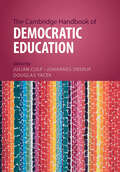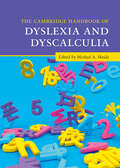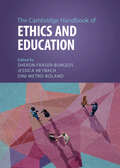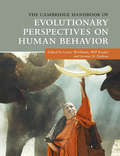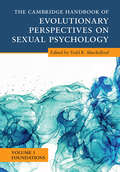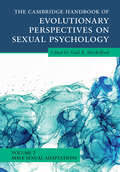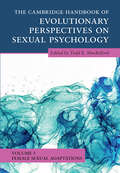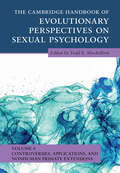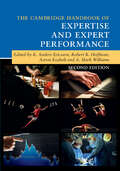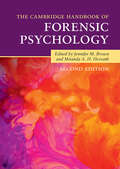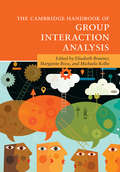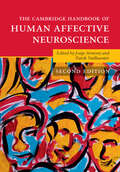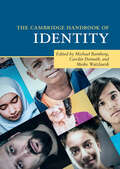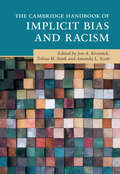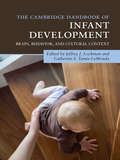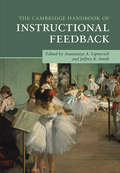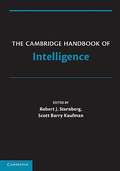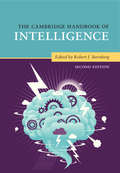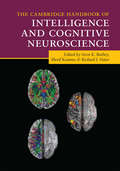- Table View
- List View
The Cambridge Handbook of Democratic Education (Cambridge Handbooks in Education)
by Johannes Drerup Julian Culp Douglas YacekWhat kind of education is needed for democracy? How can education respond to the challenges that current democracies face? This unprecedented Handbook offers a comprehensive overview of the most important ideas, issues, and thinkers within democratic education. Its thirty chapters are written by leading experts in the field in an accessible format. Its breadth of purpose and depth of analysis will appeal to both researchers and practitioners in education and politics. The Handbook addresses not only the historical roots and philosophical foundations of democratic education, but also engages with contemporary political issues and key challenges to the project of democratic education.
The Cambridge Handbook of Dyslexia and Dyscalculia (Cambridge Handbooks in Psychology)
by Michael A. SkeideIn this handbook, the world's leading researchers answer fundamental questions about dyslexia and dyscalculia based on authoritative reviews of the scientific literature. It provides an overview from the basic science foundations to best practice in schooling and educational policy, covering research topics ranging from genes, environments, and cognition to prevention, intervention and educational practice. With clear explanations of scientific concepts, research methods, statistical models and technical terms within a cross-cultural perspective, this book will be a go-to reference for researchers, instructors, students, policymakers, educators, teachers, therapists, psychologists, physicians and those affected by learning difficulties.
The Cambridge Handbook of Environment in Human Development
by Michael Lewis Linda C. MayesFamilies, communities, and societies influence children's learning and development in many ways. This is the first handbook devoted to the understanding of the nature of environments in child development. Utilizing Urie Bronfenbrenner's idea of embedded environments, this volume looks at environments from the immediate environment of the family (including fathers, siblings, grandparents, and day-care personnel) to the larger environment including schools, neighborhoods, geographic regions, countries, and cultures. Understanding these embedded environments and the ways in which they interact is necessary to understand development.
The Cambridge Handbook of Ethics and Education (Cambridge Handbooks in Education)
by Dini Metro-Roland Sheron Fraser-Burgess Jessica HeybachThis Handbook provides an interdisciplinary discussion on the role and complexity of ethics in education. Its central aim is to democratise scholarship by highlighting diverse voices, ideas, and places. It is organised into three sections, each examining ethics from a different perspective: ethics and education historically; ethics within institutional practice, and emerging ethical frameworks in education. Important questions are raised and discussed, such as the role of past ethical traditions in contemporary education, how educators should confront ethical dilemma, how schools should be organised to serve all children, and how pluralism, democracy, and technology impact ethics in education. It offers new insights and opportunities for renewal in the complex and often contentious task of ethics and education.
The Cambridge Handbook of Evolutionary Perspectives on Human Behavior (Cambridge Handbooks in Psychology)
by Lance Workman Will Reader Jerome H. BarkowThe transformative wave of Darwinian insight continues to expand throughout the human sciences. While still centered on evolution-focused fields such as evolutionary psychology, ethology, and human behavioral ecology, this insight has also influenced cognitive science, neuroscience, feminist discourse, sociocultural anthropology, media studies, and clinical psychology. This handbook's goal is to amplify the wave by bringing together world-leading experts to provide a comprehensive and up-to-date overview of evolution-oriented and influenced fields. While evolutionary psychology remains at the core of the collection, it also covers the history, current standing, debates, and future directions of the panoply of fields entering the Darwinian fold. As such, The Cambridge Handbook of Evolutionary Perspectives on Human Behavior is a valuable reference not just for evolutionary psychologists but also for scholars and students from many fields who wish to see how the evolutionary perspective is relevant to their own work.
The Cambridge Handbook of Evolutionary Perspectives on Sexual Psychology: Volume 1, Foundations (Cambridge Handbooks in Psychology)
by Todd K. ShackelfordThe interface of sexual behavior and evolutionary psychology is a rapidly growing domain, rich in psychological theories and data as well as controversies and applications. With nearly eighty chapters by leading researchers from around the world, and combining theoretical and empirical perspectives, The Cambridge Handbook of Evolutionary Perspectives on Sexual Psychology is the most comprehensive and up-to-date reference work in the field. Providing a broad yet in-depth overview of the various evolutionary principles that influence all types of sexual behaviors, the handbook takes an inclusive approach that draws on a number of disciplines and covers nonhuman and human psychology. It is an essential resource for both established researchers and students in psychology, biology, anthropology, medicine, and criminology, among other fields. Volume 1: Foundations of Evolutionary Perspectives on Sexual Psychology addresses foundational theories and methodological approaches.
The Cambridge Handbook of Evolutionary Perspectives on Sexual Psychology: Volume 2, Male Sexual Adaptations (Cambridge Handbooks in Psychology)
by Todd K. ShackelfordThe interface of sexual behavior and evolutionary psychology is a rapidly growing domain, rich in psychological theories and data as well as controversies and applications. With nearly eighty chapters by leading researchers from around the world, and combining theoretical and empirical perspectives, The Cambridge Handbook of Evolutionary Perspectives on Sexual Psychology is the most comprehensive and up-to-date reference work in the field. Providing a broad yet in-depth overview of the various evolutionary principles that influence all types of sexual behaviors, the handbook takes an inclusive approach that draws on a number of disciplines and covers nonhuman and human psychology. It is an essential resource for both established researchers and students in psychology, biology, anthropology, medicine, and criminology, among other fields. Volume 2: Male Sexual Adaptations addresses theory and research focused on sexual adaptations in human males.
The Cambridge Handbook of Evolutionary Perspectives on Sexual Psychology: Volume 3, Female Sexual Adaptations (Cambridge Handbooks in Psychology)
by Todd K. ShackelfordThe interface of sexual behavior and evolutionary psychology is a rapidly growing domain, rich in psychological theories and data as well as controversies and applications. With nearly eighty chapters by leading researchers from around the world, and combining theoretical and empirical perspectives, The Cambridge Handbook of Evolutionary Perspectives on Sexual Psychology is the most comprehensive and up-to-date reference work in the field. Providing a broad yet in-depth overview of the various evolutionary principles that influence all types of sexual behaviors, the handbook takes an inclusive approach that draws on a number of disciplines and covers nonhuman and human psychology. It is an essential resource for both established researchers and students in psychology, biology, anthropology, medicine, and criminology, among other fields. Volume 3: Female Sexual Adaptations addresses theory and research focused on sexual adaptations in human females.
The Cambridge Handbook of Evolutionary Perspectives on Sexual Psychology: Volume 4, Controversies, Applications, and Nonhuman Primate Extensions (Cambridge Handbooks in Psychology)
by Todd K. ShackelfordThe interface of sexual behavior and evolutionary psychology is a rapidly growing domain, rich in psychological theories and data as well as controversies and applications. With nearly eighty chapters by leading researchers from around the world, and combining theoretical and empirical perspectives, The Cambridge Handbook of Evolutionary Perspectives on Sexual Psychology is the most comprehensive and up-to-date reference work in the field. Providing a broad yet in-depth overview of the various evolutionary principles that influence all types of sexual behaviors, the handbook takes an inclusive approach that draws on a number of disciplines and covers nonhuman and human psychology. It is an essential resource for both established researchers and students in psychology, biology, anthropology, medicine, and criminology, among other fields. Volume 4: Controversies, Applications, and Nonhuman Primate Extensions addresses controversies and unresolved issues; applications to health, law, and pornography; and non-human primate evolved sexual psychology.
The Cambridge Handbook of Expertise and Expert Performance
by K. Anders EricssonThis 2006 book was the first handbook where the world's foremost 'experts on expertise' reviewed our scientific knowledge on expertise and expert performance and how experts may differ from non-experts in terms of their development, training, reasoning, knowledge, social support, and innate talent. Methods are described for the study of experts' knowledge and their performance of representative tasks from their domain of expertise. The development of expertise is also studied by retrospective interviews and the daily lives of experts are studied with diaries. In 15 major domains of expertise, the leading researchers summarize our knowledge on the structure and acquisition of expert skill and knowledge and discuss future prospects. General issues that cut across most domains are reviewed in chapters on various aspects of expertise such as general and practical intelligence, differences in brain activity, self-regulated learning, deliberate practice, aging, knowledge management, and creativity.
The Cambridge Handbook of Expertise and Expert Performance (Cambridge Handbooks In Psychology )
by K. Anders Ericsson Robert R. Hoffman A. Mark Williams Aaron KozbeltIn this updated and expanded edition of The Cambridge Handbook of Expertise and Expert Performance, some of the world's foremost experts on expertise share their scientific knowledge of expertise and expert performance and show how experts may differ from non-experts in terms of development, training, reasoning, knowledge, and social support. The book reviews innovative methods for measuring experts' knowledge and performance in relevant tasks. Sixteen major domains of expertise are covered, including sports, music, medicine, business, writing, and drawing, with leading researchers summarizing their knowledge about the structure and acquisition of expert skills and knowledge, and discussing future prospects. General issues that cut across most domains are reviewed in chapters on various aspects of expertise, such as general and practical intelligence, differences in brain activity, self-regulated learning, deliberate practice, aging, knowledge management, and creativity.
The Cambridge Handbook of Forensic Psychology
by Jennifer M. Brown Elizabeth A. CampbellForensic psychology has developed and extended from an original, narrow focus on presenting evidence to the courts to a wider application across the whole span of civil and criminal justice, which includes dealing with suspects, offenders, victims, witnesses, defendants, litigants and justice professionals. This handbook provides an encyclopedic-style source regarding the major concerns in forensic psychology. It is an invaluable reference text for practitioners within community, special hospital, secure unit, prison, probation and law enforcement forensic settings, as well as being appropriate for trainees and students in these areas. It will also serve as a companion text for lawyers and psychiatric and law enforcement professionals who wish to be apprised of forensic psychology coverage. Each entry provides a succinct outline of the topic, describes current thinking, identifies relevant consensual or contested aspects and alternative positions. Readers are presented with key issues and directed towards specialized sources for further reference.
The Cambridge Handbook of Forensic Psychology (Cambridge Handbooks in Psychology)
by Jennifer M. Brown Horvath, Miranda A. H.In the decade since the publication of the first edition of The Cambridge Handbook of Forensic Psychology, the field has expanded into areas such as social work and education, while maintaining the interest of criminal justice researchers and policy makers. This new edition provides cutting-edge and comprehensive coverage of the key theoretical perspectives, assessment methods, and interventions in forensic psychology. The chapters address substantive topics such as acquisitive crime, domestic violence, mass murder, and sexual violence, while also exploring emerging areas of research such as the expansion of cybercrime, particularly child sexual exploitation, as well as aspects of terrorism and radicalisation. Reflecting the global reach of forensic psychology and its wide range of perspectives, the international team of contributors emphasise diversity and cross-reference between adults, adolescents, and children to deliver a contemporary picture of the discipline.
The Cambridge Handbook of Generative Syntax
by Marcel Den DikkenSyntax – the study of sentence structure – has been at the centre of generative linguistics from its inception and has developed rapidly and in various directions. The Cambridge Handbook of Generative Syntax provides a historical context for what is happening in the field of generative syntax today, a survey of the various generative approaches to syntactic structure available in the literature and an overview of the state of the art in the principal modules of the theory and the interfaces with semantics, phonology, information structure and sentence processing, as well as linguistic variation and language acquisition. This indispensable resource for advanced students, professional linguists (generative and non-generative alike) and scholars in related fields of inquiry presents a comprehensive survey of the field of generative syntactic research in all its variety, written by leading experts and providing a proper sense of the range of syntactic theories calling themselves generative.
The Cambridge Handbook of Group Interaction Analysis (Cambridge Handbooks in Psychology)
by Margarete Boos Michaela Kolbe Elisabeth BraunerThis Handbook provides a compendium of research methods that are essential for studying interaction and communication across the behavioral sciences. Focusing on coding of verbal and nonverbal behavior and interaction, the Handbook is organized into five parts. Part I provides an introduction and historic overview of the field. Part II presents areas in which interaction analysis is used, such as relationship research, group research, and nonverbal research. Part III focuses on development, validation, and concrete application of interaction coding schemes. Part IV presents relevant data analysis methods and statistics. Part V contains systematic descriptions of established and novel coding schemes, which allows quick comparison across instruments. Researchers can apply this methodology to their own interaction data and learn how to evaluate and select coding schemes and conduct interaction analysis. This is an essential reference for all who study communication in teams and groups.
The Cambridge Handbook of Human Affective Neuroscience
by Jorge Armony Patrik VuilleumierNeuroscientific research on emotion has developed dramatically over the past decade. The cognitive neuroscience of human emotion, which has emerged as the new and thriving area of "affective neuroscience," is rapidly rendering existing overviews of the field obsolete. This handbook provides a comprehensive, up-to-date, and authoritative survey of knowledge and topics investigated in this cutting-edge field. It covers a range of topics, from face and voice perception to pain and music, as well as social behaviors and decision making. The book considers and interrogates multiple research methods, among them brain imaging and physiology measurements, as well as methods used to evaluate behavior and genetics. Editors Jorge Armony and Patrik Vuilleumier have enlisted well-known and active researchers from more than twenty institutions across three continents, bringing geographic as well as methodological breadth to the collection. This timely volume will become a key reference work for researchers and students in the growing field of neuroscience.
The Cambridge Handbook of Human Affective Neuroscience (Cambridge Handbooks in Psychology)
by Patrik Vuilleumier Jorge L. ArmonyHuman affective science has advanced rapidly over the past decades, emerging as a central topic in the study of the mind. This handbook provides a comprehensive and authoritative road map to the field, encompassing the most important topics and methods. It covers key issues related to basic processes including perception of, and memory for, different types of emotional information, as well as how these are influenced by individual, social and cultural factors. Methods such as functional neuroimaging are also covered. Evidence from clinical studies of brain disease such as anxiety and mood disorders shed new light on the functioning of emotion in all brains. In covering a dynamic and multifaceted field of study, this book will appeal to students and researchers in neuroscience, psychology, psychiatry, biology, medicine, education, social sciences, and philosophy.
The Cambridge Handbook of Identity (Cambridge Handbooks in Psychology)
by Michael Bamberg Meike Watzlawik Carolin DemuthWhile 'identity' is a key concept in psychology and the social sciences, researchers have used and understood this concept in diverse and often contradictory ways. The Cambridge Handbook of Identity presents the lively, multidisciplinary field of identity research as working around three central themes: (i) difference and sameness between people; (ii) people's agency in the world; and (iii) how identities can change or remain stable over time. The chapters in this collection explore approaches behind these themes, followed by a close look at their methodological implications, while examples from a number of applied domains demonstrate how identity research follows concrete analytical procedures. Featuring an international team of contributors who enrich psychological research with historical, cultural, and political perspectives, the handbook also explores contemporary issues of identity politics, diversity, intersectionality, and inclusion. It is an essential resource for all scholars and students working on identity theory and research.
The Cambridge Handbook of Implicit Bias and Racism (Cambridge Handbooks in Psychology)
by Jon A. Krosnick Tobias H. Stark Amanda L. ScottThe concept of implicit bias – the idea that the unconscious mind might hold and use negative evaluations of social groups that cannot be documented via explicit measures of prejudice – is a hot topic in the social and behavioral sciences. It has also become a part of popular culture, while interventions to reduce implicit bias have been introduced in police forces, educational settings, and workplaces. Yet researchers still have much to understand about this phenomenon. Bringing together a diverse range of scholars to represent a broad spectrum of views, this handbook documents the current state of knowledge and proposes directions for future research in the field of implicit bias measurement. It is essential reading for those who wish to alleviate bias, discrimination, and inter-group conflict, including academics in psychology, sociology, political science, and economics, as well as government agencies, non-governmental organizations, corporations, judges, lawyers, and activists.
The Cambridge Handbook of Infant Development: Brain, Behavior, and Cultural Context (Cambridge Handbooks in Psychology)
by Jeffrey J. Lockman Tamis-LeMonda, Catherine S.This multidisciplinary volume features many of the world's leading experts of infant development, who synthesize their research on infant learning and behaviour, while integrating perspectives across neuroscience, socio-cultural context, and policy. It offers an unparalleled overview of infant development across foundational areas such as prenatal development, brain development, epigenetics, physical growth, nutrition, cognition, language, attachment, and risk. The chapters present theoretical and empirical depth and rigor across specific domains of development, while highlighting reciprocal connections among brain, behavior, and social-cultural context. The handbook simultaneously educates, enriches, and encourages. It educates through detailed reviews of innovative methods and empirical foundations and enriches by considering the contexts of brain, culture, and policy. This cutting-edge volume establishes an agenda for future research and policy, and highlights research findings and application for advanced students, researchers, practitioners, and policy-makers with interests in understanding and promoting infant development.
The Cambridge Handbook of Instructional Feedback (Cambridge Handbooks in Psychology)
by Jeffrey K. Smith Anastasiya A. LipnevichThis book brings together leading scholars from around the world to provide their most influential thinking on instructional feedback. The chapters range from academic, in-depth reviews of the research on instructional feedback to a case study on how feedback altered the life-course of one author. Furthermore, it features critical subject areas - including mathematics, science, music, and even animal training - and focuses on working at various developmental levels of learners. The affective, non-cognitive aspects of feedback are also targeted; such as how learners react emotionally to receiving feedback. The exploration of the theoretical underpinnings of how feedback changes the course of instruction leads to practical advice on how to give such feedback effectively in a variety of diverse contexts. Anyone interested in researching instructional feedback, or providing it in their class or course, will discover why, when, and where instructional feedback is effective and how best to provide it.
The Cambridge Handbook of Intelligence
by Robert J. Sternberg Scott Barry KaufmanThis volume provides the most comprehensive and up-to-date compendium of theory and research in the field of human intelligence. Each of the 42 chapters is written by world-renowned experts in their respective fields, and collectively, they cover the full range of topics of contemporary interest in the study of intelligence. The handbook is divided into nine parts: Part I covers intelligence and its measurement; Part II deals with the development of intelligence; Part III discusses intelligence and group differences; Part IV concerns the biology of intelligence; Part V is about intelligence and information processing; Part VI discusses different kinds of intelligence; Part VII covers intelligence and society; Part VIII concerns intelligence in relation to allied constructs; and Part IX is the concluding chapter, which reflects on where the field is currently and where it still needs to go.
The Cambridge Handbook of Intelligence (Cambridge Handbooks in Psychology)
by Robert J. SternbergWritten by the foremost experts in human intelligence. It not only includes traditional topics, such as the nature, measurement, and development of intelligence, but also contemporary research into intelligence and video games, collective intelligence, emotional intelligence, and leadership intelligence. In an area of study that has been fraught with ideological differences, this Handbook provides scientifically balanced and objective chapters covering a wide range of topics. It does not shy away from material that historically has been emotionally charged and sometimes covered in biased ways, such as intellectual disability, race and intelligence, culture and intelligence, and intelligence testing. The overview provided by this two-volume set leaves virtually no area of intelligence research uncovered, making it an ideal resource for undergraduates, graduate students, and professionals looking for a refresher or a summary of the new developments.
The Cambridge Handbook of Intelligence and Cognitive Neuroscience
by Aron K. Barbey Sherif Karama Richard J. HaierThis handbook introduces the reader to the thought-provoking research on the neural foundations of human intelligence. Written for undergraduate or graduate students, practitioners, and researchers in psychology, cognitive neuroscience, and related fields, the chapters summarize research emerging from the rapidly developing neuroscience literature on human intelligence. The volume focusses on theoretical innovation and recent advances in the measurement, modelling, and characterization of the neurobiology of intelligence differences, especially from brain imaging studies. It summarizes fundamental issues in the characterization and measurement of general intelligence, and surveys multidisciplinary research consortia and large-scale data repositories for the study of general intelligence. A systematic review of neuroimaging methods for studying intelligence is provided, including structural and diffusion-weighted MRI techniques, functional MRI methods, and spectroscopic imaging of metabolic markers of intelligence.
The Cambridge Handbook of International Prevention Science
by John L. Moshe Israelashvili Romano"The Cambridge Handbook of International Prevention Science offers a comprehensive global overview on prevention science with the most up-to-date research from around the world. Over 100 scholars from 27 different countries (including Australia, Bhutan, Botswana, India, Israel, Mexico, Singapore, South Korea, Spain and Thailand) contributed to this volume, which covers a wide range of topics important to prevention science. It includes major sections on the foundations of prevention as well as examples of new initiatives in the field, detailing current prevention efforts across the five continents. A unique and innovative volume, The Cambridge Handbook of International Prevention Science is a valuable resource for established scholars, early professionals, students, practitioners and policy-makers"--
